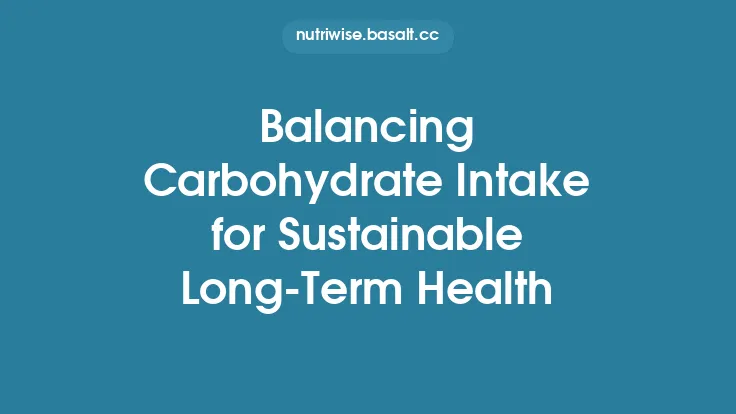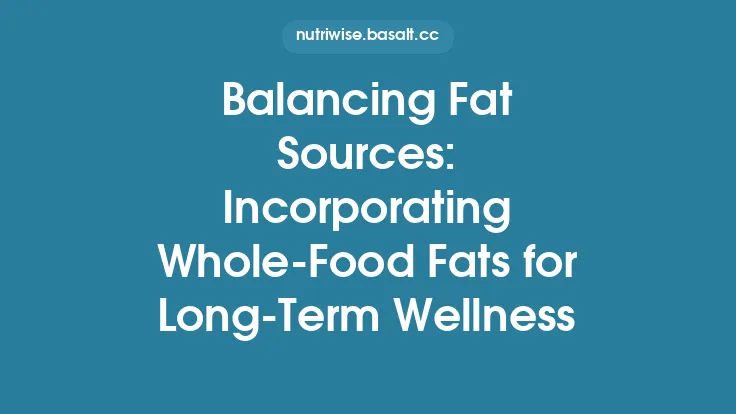Sustainable eating isn’t just about cutting calories or hitting a perfect protein‑to‑carb‑to‑fat ratio; it’s about delivering those macronutrients while preserving the planet’s finite resources. When we think about “optimal macronutrient profiles,” the conversation often stops at the plate. A truly holistic approach expands the lens to include how each gram of protein, carbohydrate, or fat is produced, transported, and ultimately discarded. By aligning macro goals with environmental stewardship, we can enjoy nutritious meals that support both personal health and planetary resilience.
Why Sustainability Matters for Macronutrient Planning
The production of food accounts for roughly a third of global greenhouse‑gas emissions, consumes more freshwater than any other sector, and drives significant land‑use change. Yet, not all macronutrients are created equal from an ecological standpoint. For example, the carbon intensity of a gram of protein can vary dramatically depending on whether it comes from legumes, beef, algae, or cultured meat. Understanding these disparities allows us to prioritize foods that deliver the needed nutrients with the smallest environmental footprint, thereby reducing our contribution to climate change, biodiversity loss, and resource depletion.
Assessing Environmental Impact of Macronutrient Sources
A robust sustainability assessment combines several key metrics:
| Metric | What It Measures | Typical Range for Common Foods* |
|---|---|---|
| Carbon Footprint (kg CO₂‑eq per kg) | Greenhouse‑gas emissions from production, processing, transport, and storage | 0.5–2 (pulses) → 5–30 (dairy) → 20–60 (beef) |
| Water Footprint (L per kg) | Total freshwater used, including irrigation and processing | 150–300 (cereals) → 1,000–2,500 (poultry) → 5,000–15,000 (red meat) |
| Land Use (m² per kg) | Area required for cultivation or grazing | 0.2–0.5 (nuts) → 2–5 (soy) → 10–30 (beef) |
| Biodiversity Impact (species‑loss index) | Pressure on ecosystems and native species | Low for most plant‑based foods, high for intensive livestock systems |
\*Values are illustrative averages; actual numbers depend on farming practices, geography, and supply‑chain efficiency.
By converting these metrics into “impact per gram of macro,” we can compare foods on a level playing field. For instance, a gram of protein from sustainably farmed beans may emit <0.01 kg CO₂‑eq, whereas the same gram from conventionally raised beef can exceed 0.1 kg CO₂‑eq—an order of magnitude difference.
Integrating Low‑Impact Protein into Your Diet
- Prioritize Emerging Protein Platforms
- Microbial protein (e.g., single‑cell proteins, mycoprotein): Produced in controlled fermenters, these proteins often require <5 % of the land and water used by traditional livestock while delivering a complete amino‑acid profile.
- Algal biomass: Spirulina and chlorella grow rapidly in brackish water, offering high‑quality protein with minimal freshwater demand.
- Leverage Regenerative Animal Systems
When animal protein is part of the plan, select sources raised under regenerative grazing or integrated crop‑livestock systems. These practices can sequester carbon in soils, improve water infiltration, and reduce the net emissions per gram of protein.
- Utilize By‑Product Proteins
- Upcycled protein isolates from food‑processing waste (e.g., oilseed press cakes) provide high‑protein powders with a negligible additional environmental load.
Choosing Carbohydrate Options with Minimal Ecological Footprint
Carbohydrates dominate the caloric intake of most diets, yet their environmental impact varies widely:
- Root and tuber crops (e.g., sweet potatoes, cassava) often thrive on marginal soils and require less fertilizer than cereal grains, translating to lower nitrogen runoff and greenhouse‑gas emissions per carbohydrate gram.
- Perennial grain systems (e.g., intermediate wheatgrass) develop deep root networks that stabilize soils and reduce the need for annual tillage, cutting both carbon emissions and erosion.
- Seaweed starches harvested from coastal farms provide digestible carbs without freshwater or arable land, offering a truly ocean‑based macro source.
When selecting carbohydrate foods, consider the yield per hectare and the input intensity (fertilizer, pesticide, irrigation). High‑yield, low‑input crops deliver more carbs for the same land area, thereby reducing the overall footprint.
Fats that Align with Planetary Health Goals
Fats are energy‑dense, so a small quantity can meet a substantial portion of daily caloric needs. Sustainable fat sourcing focuses on maximizing nutritional value while minimizing land and water use:
- Microbial and algal oils: Produced in bioreactors, these oils can be tailored to contain high levels of omega‑3 fatty acids without the overfishing pressures associated with marine fish oils.
- Oilseed residues: After oil extraction, the remaining cake can be repurposed as a protein‑rich feed or food ingredient, ensuring that the entire plant is utilized.
- Silvopastoral systems: Cattle grazing under tree canopies produce milk and meat with a modest increase in fat content, while the trees sequester carbon and improve biodiversity.
Meal Planning Strategies that Maximize Macro Efficiency and Reduce Waste
- Macro‑Balanced Batch Cooking
- Design weekly menus around a target macro distribution (e.g., 30 % protein, 45 % carbohydrate, 25 % fat).
- Prepare base components (e.g., a protein‑rich broth, a carbohydrate‑dense grain blend, a fat‑enhanced sauce) that can be recombined in multiple meals, reducing duplicate ingredient purchases.
- Portion‑Based Ingredient Scaling
- Use digital tools to calculate the exact gram weight of each macro needed per serving, then purchase ingredients in bulk quantities that match those calculations, minimizing excess.
- Zero‑Waste Utilization
- Incorporate stems, leaves, and peels into stocks, smoothies, or fermented condiments. This not only salvages nutrients but also reduces the embodied emissions associated with discarded biomass.
- Cold‑Chain Optimization
- Store pre‑portioned macro components at appropriate temperatures to extend shelf life, thereby avoiding spoilage that would otherwise waste the macro content.
The Role of Food Production Innovations in Sustainable Macro Nutrition
- Vertical Farming: By stacking crops in controlled environments, vertical farms dramatically reduce land use and can recycle water at >90 % efficiency. Leafy greens and certain tubers grown vertically can supply carbohydrates and micronutrients with a fraction of the traditional footprint.
- Precision Agriculture: Satellite‑guided variable‑rate application of fertilizers and irrigation ensures that each field receives exactly what it needs, cutting excess nitrogen runoff—a major driver of greenhouse‑gas emissions from agriculture.
- Cell‑Based Meat: Cultured muscle tissue eliminates the need for animal rearing, slashing land use and methane emissions while delivering a protein source with a familiar macro profile.
- Circular Food Systems: Integrating waste streams (e.g., food‑processing effluents) into the production of protein isolates or bio‑based fats creates closed loops that keep macro nutrients in circulation rather than exiting the system as waste.
Guidelines for Evaluating Sustainable Food Choices
- Check Life‑Cycle Assessment (LCA) Scores
Look for certifications or databases (e.g., the Food Carbon Emissions Database) that provide LCA data per gram of macro.
- Prioritize Local and Seasonal Production
Shorter transport distances reduce fuel consumption, and seasonal crops typically require fewer inputs.
- Assess Production Practices
Regenerative agriculture, organic certification, and animal welfare standards often correlate with lower environmental impact, though they should be verified against independent audits.
- Consider End‑of‑Life Scenarios
Foods that are compostable or biodegradable reduce landfill methane emissions, completing the sustainability cycle.
Practical Tips for Everyday Sustainable Macro Balancing
- Build a “Macro‑Footprint” Spreadsheet: Log the grams of protein, carbs, and fats per meal alongside the associated carbon and water footprints. Over time, patterns emerge that guide smarter substitutions.
- Swap High‑Impact Items First: Replace a portion of red‑meat protein with a microbial or algae‑based alternative before tackling other macro categories.
- Leverage Community Resources: Join local food co‑ops or community‑supported agriculture (CSA) programs that prioritize low‑impact farming methods.
- Educate the Palate: Gradually introduce new sustainable macro sources (e.g., seaweed noodles, fermented bean pastes) to allow taste adaptation without abrupt dietary shifts.
- Track Food Waste: Use kitchen scales to measure leftovers and plan “use‑it‑up” meals, ensuring that the macro content you purchase is fully realized in your diet.
By weaving together macro‑nutrient goals with a rigorous assessment of environmental impact, we can craft diets that nourish both body and Earth. The key lies in viewing each gram of protein, carbohydrate, and fat not just as a nutritional unit, but as a resource that carries an ecological story—one we have the power to rewrite toward a more sustainable future.





